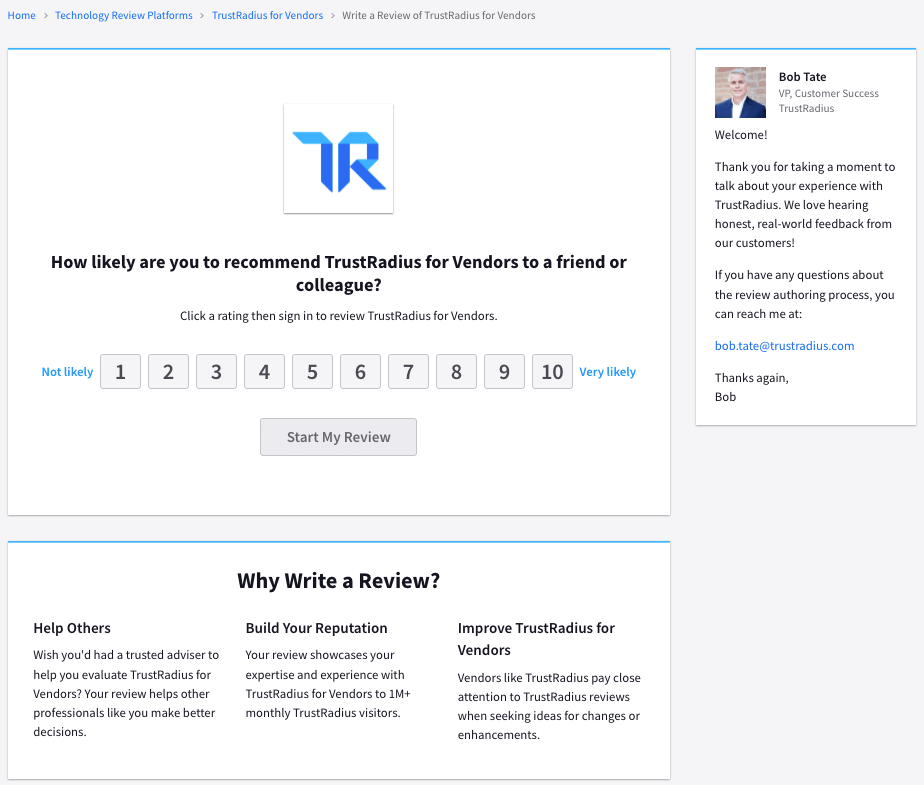3 Strategies for Sourcing Customer Reviews on Multiple Platforms
If you’re a marketer at a software company, you know there are several review platforms vying for your buyers’ attention—and therefore yours too!
Here’s what we know about today’s tech buyer:
- They want to self-serve
- They rely on Google
- Their paths aren’t linear
- They trust their peers more than you
So you’re right in thinking you need to pay attention to at least the top handful of software review sites. Reviews on Gartner Peer Insights influence their flagship and time-honored Magic Quadrant (MQ). G2 boasts the largest organic traffic number. TrustRadius boasts the highest quality reviews, the most engaged audience, and the strongest intent data signals. Capterra can get you leads. And based on SEMRush data, monthly audience overlaps across these four sites are small (20% or less).
If you’re worried about over-tapping your customer base to make sure you’ve got a presence across all the sites you care about, never fear. With the right strategy, you can have your review cake, and eat it too.
Your customers like to help
When one of your customers writes a review, it’s not just helping you… it’s helping their peers. The act of writing a software review carries a few intrinsic motivations for professionals: being valued as an expert, helping others, and providing feedback to a vendor whose product they rely on.
If you’re not convinced that it’s ok to ask, here’s a few stats:
- 45% of people who write a review on TrustRadius say they’re willing to be a customer reference for the vendor
- Three out of four buyers say they are willing to advocate for the product they bought
- People who’ve written a review on one site are up to six times more likely to write another one compared to those who’ve never written one
Here are three strategies that can work and why you might choose each one.
Option 1: Random segmentation
One simple strategy is to randomly segment your list across the sites you want reviews on. For example, if email is your chosen channel, split your list of customers into equal parts and send an invitation for one review site. If you’re using a prompt within your product to solicit reviews, segment the different prompts equally as well.
This is a good option if:
- You’ve got a large enough customer base to drive meaningful results
- You want simplicity
- Your tools allow for random segmentation
- You’re new to the review game and quickly need a presence on all sites
- You’re not concerned about the differences across the review sites
You also don’t have to stop here. You can wait a month or two and swap the invitations. You can either invite everyone again or invite just those who took you up on the first offer, since they’ll be more likely to take you up on a second one.

Option 2: Three-in-one
Another strategy is to get your users to contribute feedback across all sites in one go. You can send one invitation with an offer to write a review on three sites, for example. You can present this as an option for your customers to pick (though they may not have a known preference), or offer an extra thank-you incentive for those who contribute multiple reviews.
This is a good option if:
- You need to increase your presence across multiple platforms quickly
- You may not have a large enough user base to drive meaningful results with Option 1
- You’ve got the time and ability to manage extra incentives for customers who write multiple reviews
Option 3: A tailored approach
If you’re mature in your review platform usage, you can create your own tailored approach based on the value you get from each platform. You’ll want to consider factors such as the timing of awards and accolades of each site, the types of content you’re able to generate, each site’s audience and what they’re looking for, and how you are able to package and use review content in your own channels.
Here are some factors to help inform your approach:
- TrustRadius reviews are the most detailed and in-depth. Start by sending your most engaged customers to TrustRadius to take full advantage of the level of insights they’re able to offer your buyers, both on our site and in your own sales and marketing channels. We can later ask them to augment their reviews by answering additional questions, meaning you can easily build an arsenal of great content on TrustRadius over time from those customers.
- Time your Gartner Peer Insights review efforts to make sure you meet the requirements for the MQ. (Although you may want to also ensure you’ve got review content on TrustRadius, since over the past year we’ve had 2,000 visits from Gartner analysts.)
- TrustRadius has a robust calendar of valuable awards: Top Rated, Best Software, Most Loved, and more. Check out our 2022 calendar here, and keep the review threshold deadlines in mind.
- G2 offers grid-based awards quarterly. Time your G2 reviews to ensure you meet those deadlines and requirements.
- Because of our focus on quality and depth, TrustRadius meets the needs of enterprise buyers better than other review sites. So if you serve an enterprise segment, make sure they are represented in your TrustRadius reviews.
- Any users you want on record? Remember that all reviews on GPI are anonymous. Just over half of reviewers on TrustRadius choose to be public with their reviews, meaning you can attribute their quotes with their name and company.
- TrustRadius will customize your review questions based on your content needs. Are you trying to move up-market? Are you looking for customer quotes that support how your solution wins against your competitors? Are you looking to identify cross-sell or upsell opportunities? Segment your customers based on the content you’re aiming to source on TrustRadius and the questions we’re asking.
Whichever option you choose first, make sure you factor in maintenance afterward. Buyers trust recent reviews more than older ones. Once you’ve achieved a minimum threshold, it’s better to create a steady stream of reviews rather than one big push that ages out.
If you need help, talk to your TrustRadius CSM, request a consultation with our review generation strategy team, or request a demo.















